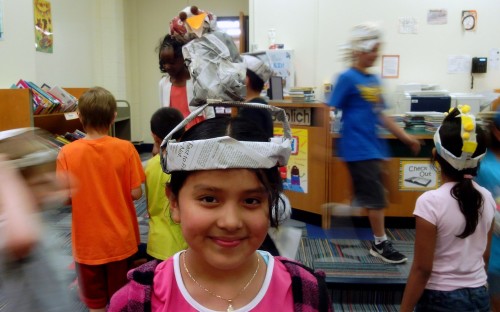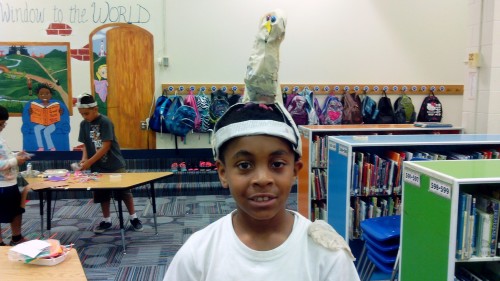
What happens when kids use fun fictional texts that have a basis in science, technology, engineering and math as a springboard to explore the science behind the fiction? This week, I’ve invited Gillian King-Cargile, Director of Northern Illinois University’s STEM Read program, to share her observations with a fifth grade class. This post is brought to you in partnership with Follett Learning, a longtime supporter of The Cornerstone.
“I thought this was gonna suck.”
That’s what a fifth grader said to me during a recent school visit. We were in an elementary school library. Around us, other fifth graders were elbow deep in bins of newspaper, masking tape, Popsicle sticks and googly eyes, but this kid was just leaning against a book shelf with his hands in his pockets and a smirk on his face. He glared around the room like he owned the library…or hated the library. I couldn’t decide which.
My STEM Read team from Northern Illinois University was visiting the school to read Andrea Beaty’s fabulous picture book Rosie Revere, Engineer and then lead students in a hands-on engineering challenge. See, little Rosie loves to create gadgets and gizmos. One of her wackiest inventions is a cheese-spraying hat that keeps snakes off her zookeeper uncle’s head.

We walked students through the engineering design process. We shared a video interview with the director of the Midwest Museum of Natural History to give students background information on snakes and the different things that attract and repel them. After the video, we asked students to come up with different things they might include in a design for a snake-repelling helmet. Then we set the students loose with craft supplies so that they could design and build their own helmets.
Around me and the young king of the library, helmets began to take shape. Students wadded up newspaper and mummy wrapped it in masking tape to sculpt owls, hawks and mongooses. Others created intricate systems of spikes and catapults to drive snakes away.

One student used almost all of my googly eyes. She said she wanted the snakes to think several predators were watching from inside her hat.
A boy spent the entire session building a tower on top of his helmet. His plan was to make the tower too steep and high for a snake to slither up. He started with construction paper. When that was too flimsy, he reinforced the structure with pipe cleaners and tape. Every layer of his tower was a fuzzy, colorful feat of architecture. There was no right answer to the challenge – students just needed to think of a creative solution and then try to make it happen.
“Well,” I said to the kid who was still leaning too-cool-for-school against the bookshelf, “Does this suck?”
“No,” he said. “This is pretty fun.” Then he showed me the hat he’d made. “It’s a honey badger,” he said proudly. “They eat venomous snakes.” Then he asked me if he could take some craft supplies home to show his little brother how to make a snake-repelling helmet, too.

At STEM Read, we look for fun fiction books that have a basis in science, technology, engineering and math. Then we create educator lesson plans, interactive games, creative writing prompts, expert videos and other open educational resources to help readers explore the science behind the fiction.
We feel that books like Rosie Revere, Engineer; Dark Life by Kat Falls; Carnivores by Aaron Reynolds; Fuzzy Mud by Louis Sachar; and STEM Read’s own picture book The Toy and the Twister have a place in the school library and the science classroom. These fiction books have the potential to serve as a gateway to great learning, a hook to harder subjects. But educators need to have the tools and resources to connect creativity to concrete STEM concepts.
Follett School Solutions is helping educators find the materials they need to support STEM initiatives. Follett’s Science and Literacy Connections Program™ offers teachers an abundance of science material and informational books broken down by grade and aligned to state and national standards.
The program is research-based and focuses on best practices for literacy development. Their Content Alignment Services team of educators and librarians are able to find fiction and nonfiction titles that support science, technology, engineering and math – for free. Follett’s Science and Literacy Connections Program and Content Alignment Services are the perfect pair for fiction and nonfiction STEM materials.
I love the idea of pairing great fiction with useful informational texts.
I love seeing that lightbulb go off when students make connections and understand a challenging subject.
I love how we can use fiction to reinforce cross-cutting and interdisciplinary concepts. Students need to know these things for tests, but they also need to know them because the world where they will live and work is interdisciplinary.
Most of all, I love making learning not suck for students like my young friend in that elementary school library. I hope that STEM Read, Follett’s Science and Literacy Connections Program and Content Alignment Services can help you do that, too.

Angela Watson
Founder and Writer
Sign up to get new Truth for Teachers articles in your inbox
OR

Join our
community
of educators
If you are a teacher who is interested in contributing to the Truth for Teachers website, please click here for more information.
















Discussion